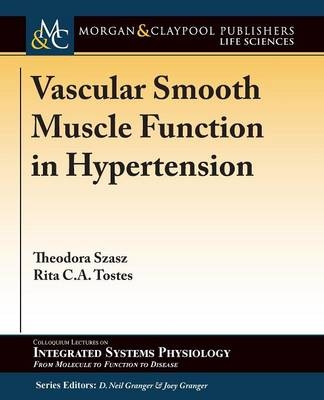
Vascular Smooth Muscle Function in Hypertension
Morgan and Claypool Life Sciences (Verlag)
978-1-61504-684-3 (ISBN)
Hypertension is defined by an increase in systemic blood pressure above limits considered normal, currently set at 140 mmHg for systolic and 90 mmHg for diastolic pressure. Assuming central venous pressure to be near zero, mean arterial pressure is determined by the product of total peripheral resistance and cardiac output. In most cases of essential hypertension, as well as in animal models of hypertension, cardiac output and its main determinants, stroke volume and heart rate, are normal, whereas total peripheral resistance is increased. Total peripheral resistance is influenced by a number of factors described by the Poiseuille’s law, the most significant of which by far is the diameter of blood vessels of the arterial tree. Since blood vessel diameter is a reflection of both vascular structure and active regulation of vascular tone through mechanisms of vasoconstriction and vasodilatation, it is generally considered that alterations in total peripheral resistance are directly determined by alterations in vascular smooth muscle structure and/or function. Thus, complex blood pressure regulation systems, including renal, nervous, endocrine, immune, and others, in their turn influenced by genetic or environmental factors, converge upon the same molecular mechanisms that control the structure and function of vascular smooth muscle. In this work, rather than providing the exhaustive list of modifications in the blood pressure regulating systems that ultimately affect the vasculature in hypertension, we will focus on the structural and functional alterations of vascular smooth muscle per se during hypertension.
Theodora Szasz was born and brought up in Romania. She received her M.D. from the Iuliu Hatieganu University of Medicine and Pharmacy in Cluj-Napoca, Romania, and her Ph.D. in microbiology and molecular genetics from Michigan State University, East Lansing, Michigan. Her interest in smooth muscle function began with her graduate work, which was completed under the supervision of Dr. Stephanie Watts in the Pharmacology and Toxicology Department at Michigan State University. During her Ph.D., Dr. Szasz studied the role of reactive oxygen species in modulating venomotor tone during hypertension. Dr. Szasz is now a postdoctoral fellow in the Physiology Department at Augusta University, where she works with Dr. Clinton Webb. Her main research interest is integrative cardiovascular physiology, with a focus on the physiology and pharmacology of smooth muscle, as well as the correlations between risks for cardiovascular disease (hypertension, obesity, diabetes) and mechanisms of vascular dysfunction. Rita C. Tostes was born in Brodowski, in the Southeast of Brazil. She received her Ph.D. in Pharmacology at the Ribeirao Preto Medical School, University of Sao Paulo. She was introduced to cardiovascular research by Professors Lusiane M. Bendhack and Ana Maria de Oliveira, in Brazil. Her training in vascular physiology and pharmacology included the mentorship of Professors R. Clinton Webb (Augusta, Georgia), Maria Helena Carvalho (Sao Paulo, Brazil), Ernesto L. Schiffrin (Montreal, Quebec), and Rhian M. Touyz (Glasgow, Scotland). With them she discovered the exciting world of cellular and molecular mechanisms involved in the regulation of vascular function under physiological and, particularly, under pathological conditions. Her research group investigates the mechanisms causing vascular dysfunction in cardiovascular and metabolic diseases. She has a special interest in the role of sex hormones, aldosterone, endothelins, and the immune system in the development and progression of arterial hypertension and in the complications associated with diabetes and obesity.
Historical Considerations on Early Physiological Studies of the Cardiovascular System
An Overview of Vascular Physiology
Alterations in Vascular Smooth Muscle Contraction in Hypertension
Mechanisms of Vascular Smooth Muscle Dysfunction in Hypertension
Vascular Remodeling in Hypertension
Vascular Smooth Muscle Cell Interactions in the Vascular Wall
Concluding Remarks
References
Author Biographies and Acknowledgments
| Erscheinungsdatum | 05.11.2016 |
|---|---|
| Reihe/Serie | Colloquium Series on The Developing Brain |
| Verlagsort | San Rafael, CA |
| Sprache | englisch |
| Maße | 191 x 235 mm |
| Gewicht | 525 g |
| Themenwelt | Medizin / Pharmazie ► Medizinische Fachgebiete |
| Studium ► 1. Studienabschnitt (Vorklinik) ► Physiologie | |
| ISBN-10 | 1-61504-684-4 / 1615046844 |
| ISBN-13 | 978-1-61504-684-3 / 9781615046843 |
| Zustand | Neuware |
| Informationen gemäß Produktsicherheitsverordnung (GPSR) | |
| Haben Sie eine Frage zum Produkt? |
aus dem Bereich


